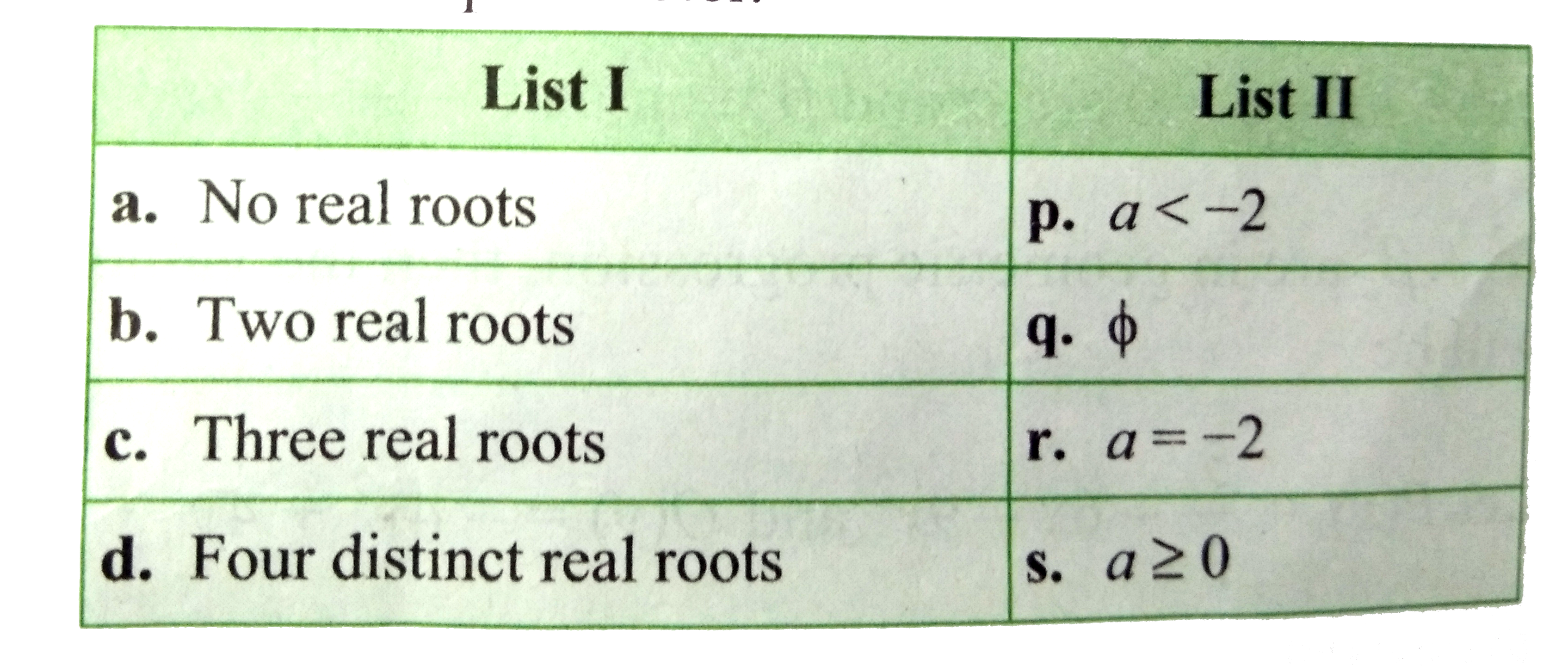If the equation x4−λx2+9=0 has four real and distinct roots, then λ lies in the intervalSolution in Bengali
(−∞,−6)∪(6,∞)
(0,∞)
(6,∞)
(−∞,−6)
The correct Answer is:C
x4−λx2+9=0
Let x2=t≥0
∴f(t)=t2−λt+9=0 (1)
If given equation has four real and distinct roods, then both roots of (1) must be positive
∴D>0⇒λ2−36>0 (2)
−b2a>0⇒λ2>0orλ>0 (3)
f(0)>or9>0 (4)
∴λ∈(−6,∞) [from(2),(3),(4)].
Topper's Solved these Questions
- BOOK - CENGAGE PUBLICATIONCHAPTER - THEORY OF EQUATIONSEXERCISE - MATRIX MATCH TYPE6videos
THEORY OF EQUATIONS
- BOOK - CENGAGE PUBLICATIONCHAPTER - THEORY OF EQUATIONSEXERCISE - NUMERICAL VALUE TYPE43videos
THEORY OF EQUATIONS
- BOOK - CENGAGE PUBLICATIONCHAPTER - THEORY OF EQUATIONSEXERCISE - Multiple Correct Answer Type38videos
THEORY OF EQUATIONS
- BOOK - CENGAGE PUBLICATIONCHAPTER - STRAIGHT LINESEXERCISE - ARCHIVES (NUMERICAL VALUE TYPE)1videos
STRAIGHT LINES
- BOOK - CENGAGE PUBLICATIONCHAPTER - THREE DIMENSIONAL GEOMETRYEXERCISE - All Questions291videos
THREE DIMENSIONAL GEOMETRY
Similar Questions
Match the following for the equation x2+a|x|+1=0 where, a is a parameter.
 04:06View Solution
04:06View SolutionIf x=2+22/3+21/3 , then the value of x3−6x2+6x is
04:31View SolutionIf c≠0 and the equation p2x=ax+c+bx−c has two equal roots, then p can be
01:58View SolutionFor a point P in the plane, let d1(P)andd2(P) be the distances of the point P from the lines x−y=0andx+y=0 respectively. The area of the region R consisting of all points P lying in the first quadrant of the plane and satisfying 2≤d1(P)+d2(P)≤4, is
02:04View SolutionFind the angle between the line whose direction cosines are given by l+m+n=0andl2+m2−n2=0.
03:48View SolutionIf both the roots of the quadratic equation x2−mx+4=0 are real and distinct and they lie in the interval [1, 5], then m lies in the interval
View SolutionIf both the roots of the quadratic equation x2−mx+4=0 are real and distinct and they lie in the interval [1,5], then m lies in the interval
06:40View SolutionIf the equation x^4- λx^2+9=0 has four real and distinct roots, then λ lies in the interval
03:57View SolutionIf the equation x^4 -λx^2 +9 has only two real roods, then the set of values of λ is
04:00View SolutionIf the roots of the equation x^(2)+2ax+b=0 are real and distinct and they differ by at most 2m, then b lies in the interval
05:02View SolutionLet a,b and s be the sides of a scalane triangle. IF λ is a real number such that the roots of the equation
x2+2(a+b+c)x+3λ(ab+bc+ca)=0 are real, then the interval in which λ lies is01:37View SolutionIf both the roots of the quadratic equation x2−mx+4=0 are real and distinct and they lie in the interval [1, 5], then m lies in the interval
07:13View Solution(B) (2, 9/4) If two roots of the equation (a−1)(x2+x+1)2−(a+1)(x4+x2+1)=0 are real and distinct, then a lies in the interval
03:00View SolutionIf the equation x4−λx2+9=0 has four real and distinct roots, then λ lies in the interval
01:36View SolutionIf the equation has no real root, then λ lies in the interval
01:24View SolutionIf the equation x^4 -λx^2 +9 has only two real roods, then the set of values of λ is
03:15View Solution

